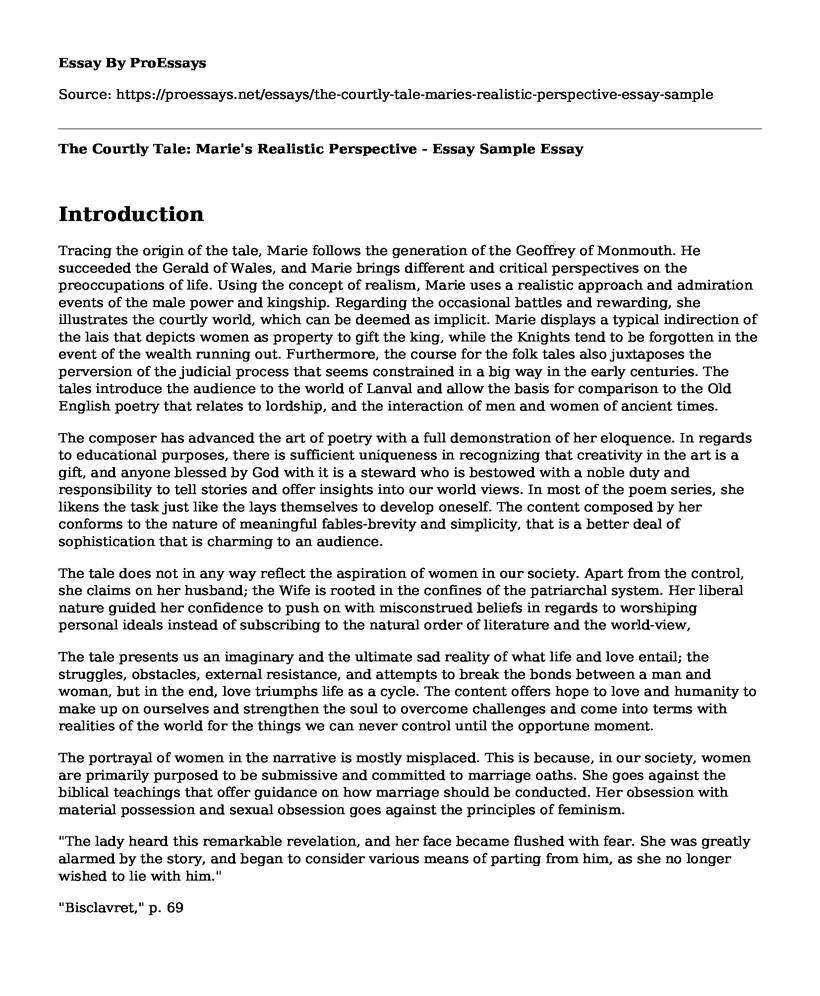Introduction
Tracing the origin of the tale, Marie follows the generation of the Geoffrey of Monmouth. He succeeded the Gerald of Wales, and Marie brings different and critical perspectives on the preoccupations of life. Using the concept of realism, Marie uses a realistic approach and admiration events of the male power and kingship. Regarding the occasional battles and rewarding, she illustrates the courtly world, which can be deemed as implicit. Marie displays a typical indirection of the lais that depicts women as property to gift the king, while the Knights tend to be forgotten in the event of the wealth running out. Furthermore, the course for the folk tales also juxtaposes the perversion of the judicial process that seems constrained in a big way in the early centuries. The tales introduce the audience to the world of Lanval and allow the basis for comparison to the Old English poetry that relates to lordship, and the interaction of men and women of ancient times.
The composer has advanced the art of poetry with a full demonstration of her eloquence. In regards to educational purposes, there is sufficient uniqueness in recognizing that creativity in the art is a gift, and anyone blessed by God with it is a steward who is bestowed with a noble duty and responsibility to tell stories and offer insights into our world views. In most of the poem series, she likens the task just like the lays themselves to develop oneself. The content composed by her conforms to the nature of meaningful fables-brevity and simplicity, that is a better deal of sophistication that is charming to an audience.
The tale does not in any way reflect the aspiration of women in our society. Apart from the control, she claims on her husband; the Wife is rooted in the confines of the patriarchal system. Her liberal nature guided her confidence to push on with misconstrued beliefs in regards to worshiping personal ideals instead of subscribing to the natural order of literature and the world-view,
The tale presents us an imaginary and the ultimate sad reality of what life and love entail; the struggles, obstacles, external resistance, and attempts to break the bonds between a man and woman, but in the end, love triumphs life as a cycle. The content offers hope to love and humanity to make up on ourselves and strengthen the soul to overcome challenges and come into terms with realities of the world for the things we can never control until the opportune moment.
The portrayal of women in the narrative is mostly misplaced. This is because, in our society, women are primarily purposed to be submissive and committed to marriage oaths. She goes against the biblical teachings that offer guidance on how marriage should be conducted. Her obsession with material possession and sexual obsession goes against the principles of feminism.
"The lady heard this remarkable revelation, and her face became flushed with fear. She was greatly alarmed by the story, and began to consider various means of parting from him, as she no longer wished to lie with him."
"Bisclavret," p. 69
In agreement with her, the fork tale series content illustrates the nature and circles in this world that keep close to our paths in proof that time travels, but our aspirations and yearn to redefine our souls is a course that we should never relent.
Works Cited
Lais of Marie de France (1160-1215 AD) Reading: Prologue, Lanval, Laustic (The Nightingale)
Cite this page
The Courtly Tale: Marie's Realistic Perspective - Essay Sample. (2023, Aug 13). Retrieved from https://proessays.net/essays/the-courtly-tale-maries-realistic-perspective-essay-sample
If you are the original author of this essay and no longer wish to have it published on the ProEssays website, please click below to request its removal:
- Destiny Against Individual Choice in The Tales of Canterbury. Literary Essay Sample.
- Book Review: And Then There Were None
- The Role of the Narrator in Harper Lee's To Kill a Mockingbird: Literary Analysis Essay
- If Willy Loman Has a Tragic Flaw, What Might It Be, and How Does It Lead To His Death?
- Essay Sample on George Orwell's Position on Imperialism
- Literary Analysis Essay on The Story of an Hour by Kate Chopin: A Tragic Tale of Louise Mallard's Heartbreaking Loss
- Essay Example on Rip Van Winkle: An American Tale of Revolution and Resistance







